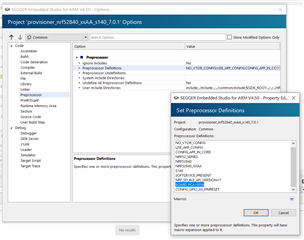So the goal of what I'm doing is I have a Wurth Proteus III and I want to run the NRF Mesh SDK provisioner on the Proteus III. I have been told that this is possible and through my research online have found documentation on how to do this. That being said I'm having plenty of issues even getting the provisioner application to build the solution before I even flash it.
The link above is the documentation I found on how to do it (starting on page 26 is where the tutorial begins). The main issue I'm having is where it says to link the Proteous III hardware instead of the nordic evaluation board hardware. By adding the BOARD_PROTEUSI macro and removing the nordic macro. Where is this done in Segger? When I try to link the Proteus III and then build the solution I just get an "Error starting process = " Message.
I know that this is an odd question because I'm using Wurth hardware but I figured I'd give it an ask since it's nordic's Mesh SDK I'm trying to run on it.
Any help is appreciated,
Thanks



